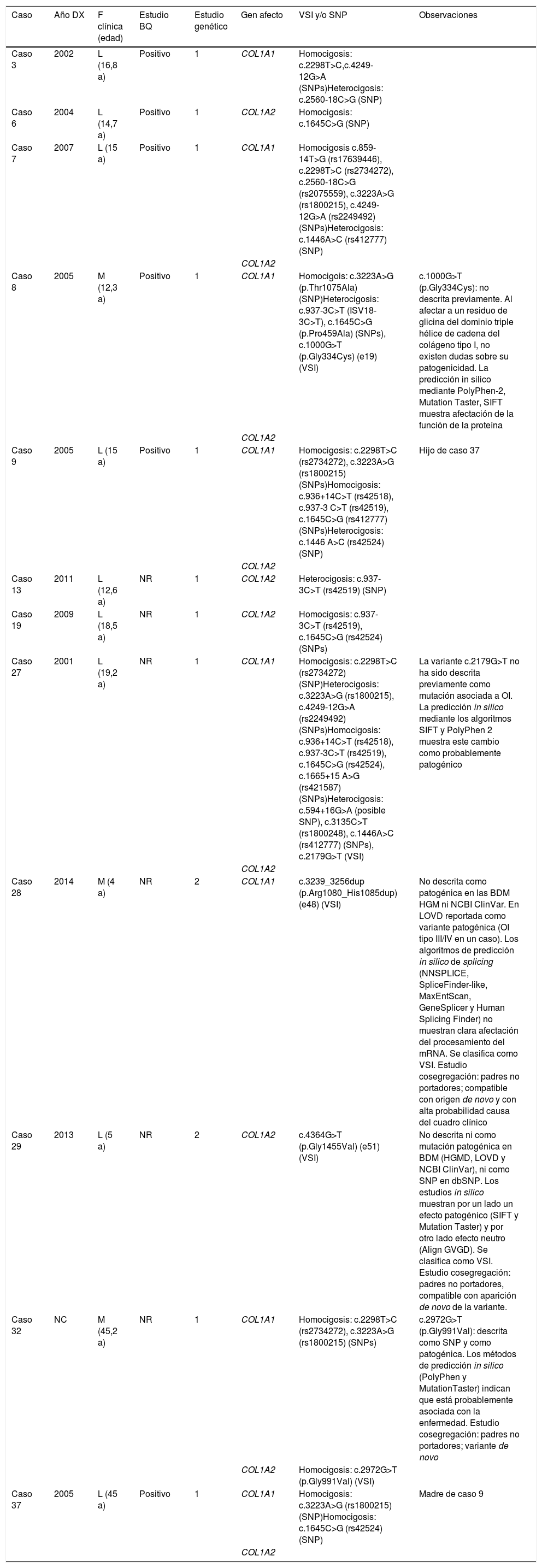La osteogénesis imperfecta (OI) es una enfermedad genética heterogénea manifestada como fragilidad ósea y fracturas.
Pacientes y métodosEstudio descriptivo retrospectivo analizando características clínicas, genéticas y tratamiento de pacientes diagnosticados de OI (1989-2017) en el Hospital Universitario Miguel Servet, Zaragoza (Endocrinología Pediátrica y Reumatología).
ResultadosIncluidos 40 pacientes; 32,5% varones, 67,5% mujeres; 29 niños, 11 adultos. Media de fracturas al diagnóstico en OI leve 4,6±6,4 (edad media al diagnóstico 7,8±12,8años), en OI moderada 1,7±2,4 (edad media al diagnóstico 0,04±0,3años), en OI grave 3,7±2,1 y en OI muy grave 12,5±7,8, ambos grupos diagnosticados al nacimiento. Estudio genético en 32 pacientes, 25 con variante patogénica/probablemente patogénica, siendo COL1A1 el gen más frecuentemente afectado. En 7 pacientes no fue encontrada la variante responsable, 5 con confirmación diagnóstica (estudio bioquímico colágenoI). Tratamiento con bifosfonatos 19 pacientes; 7 asociando hormona de crecimiento. Los tratados con bifosfonatos han presentado mejoría clínica (reducción de dolor óseo y/o irritabilidad) y reducción del número de fracturas.
ConclusionesEl gen COL1A1 es el más frecuentemente afectado en nuestros pacientes. El tratamiento debe ser multidisciplinar y el uso de bifosfonatos proporciona mejoría.
Osteogenesis imperfecta (OI) is a heterogeneous genetic disease manifesting as bone fragility and fractures.
Patients and methodsRetrospective descriptive study analysing clinical and genetic features, and treatment of patients with OI.
ResultsForty patients were included; 32.5% males, 67.5% females; 29 children, 11 adults. Number of fractures at diagnosis with mild OI was 4.6±6.4 (average age at diagnosis 7.8±12.8years), with moderate OI 1.7±2.4 (age at diagnosis .04±.3years), in severe OI 3.7±2.1 and in extremely severe forms 12.5±7.8, both groups diagnosed at birth. Genetic study in 32 patients, 25 with a positive genetic study (pathogenic/probably pathogenic variant). COL1A1 gene was the most frequently affected. In 7 patients, no pathogenic or probably pathogenic variant was found (5 diagnosed by biochemical study of typeI collagen). Nineteen patients were treated with bisphosphonates; 7 combined with growth hormone. The patients treated with bisphosphonates showed clinical improvement (reduction of bone pain and/or irritability) and reduction of fractures.
ConclusionsThe COL1A1 gene is the most frequently affected. OI patients should receive multidisciplinary management and bisphosphonates can improve their quality of life.










